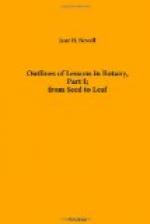[Footnote 1: The first winter that I examined Horsechestnut buds I found, in many cases, that the axillary shoots had from a quarter of an inch to an inch of wood before the first set of rings. I could not imagine what had formed this wood, and it remained a complete puzzle to me until the following spring, when I found in the expanding shoots, that, wherever a flower-cluster was present, there were one or two pairs of leaflets already well developed in the axils, and that the next season’s buds were forming between them, while the internodes of these leaflets were making quite a rapid growth. Subsequently, I found the leaflets also in the buds themselves. I found these leaflets developed on the tree only in the shoots containing flower-clusters, where they would be needed for the future growth of the branches. I suppose the reason must be that the flower-cluster does not use all the nourishment provided and that therefore the axillary buds are able to develop. It would be interesting to know what determines the stronger growth of the one which eventually becomes the leader.]
There is one thing more the pupils may have noticed. The small round dots all over the young stem, which become long rifts in the older parts, are breaks in the epidermis, or skin of the stem, through which the inner layers of bark protrude. They are called lenticels. They provide a passage for gases in and out of the stem. In some trees, as the Birch, they are very noticeable.
After discussing the subject thoroughly in the class-room, the pupils should rewrite their papers, and finally answer the following questions, as a species of review. I have thus spent three recitations on the Horsechestnut. The work is all so new, and, if properly presented, so interesting, that a good deal of time is required to exhaust its possibilities of instruction. If the teacher finds his scholars wearying, however, he can leave as many of the details as he pleases to be treated in connection with other branches.
QUESTIONS ON THE HORSECHESTNUT.
How many scales are there in the buds you have examined?
How are they arranged?




